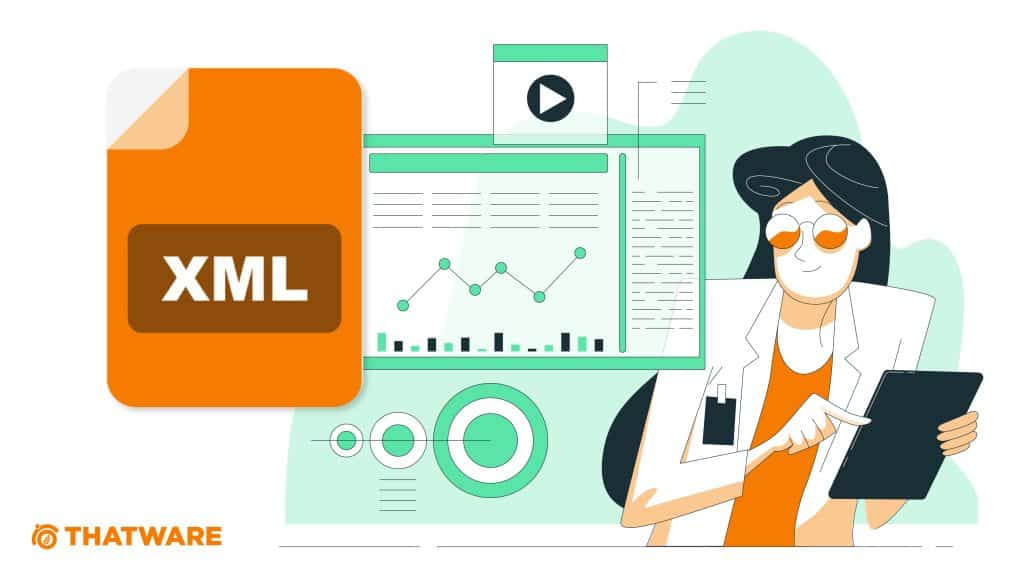SUPERCHARGE YOUR ONLINE VISIBILITY! CONTACT US AND LET’S ACHIEVE EXCELLENCE TOGETHER!
Data is described using XML (Extensible Markup Language). The XML standard is a versatile method for creating information formats and electronically sharing structured data over the public internet and corporate networks.
XML is a markup language based on the Standard Generalized Markup Language (SGML), which is used to define markup languages.
The primary function of XML is to develop data formats that encode information for documentation, database records, transactions, and a variety of other types of data. You can use XML data to generate various content types by constructing dissimilar types of content based on the XML data, such as web, print, and mobile content.
Like Hypertext Markup Language (HTML), XML documents are stored as American Standard Code for Information Interchange (ASCII) files and can be edited with any text editor.

What Is The Purpose Of XML?
According to the World Wide Web Consortium (W3C), the web’s standards body, the primary function of XML is to provide a “simple text-based format for representing structured information,” including for the following:
- underlying data formats for applications such as Microsoft Office;
- technical documentation;
- application software configuration options;
- books;
- transactions; and
- invoices.
XML allows for the exchange of structured information between and among the following:
- programs and programs;
- programs and people; and
- locally and across networks.
The World Wide Web Consortium (W3C) defines the XML standard and recommends its use for web content. While XML and HTML are both based on the SGML platform, the W3C has also defined the XHTML and XHTLM5 document formats, which mirror the HTML and HTML5 web content standards, respectively.
How Does XML Function?
XML functions by providing a consistent data format. Formatting is strictly enforced in XML; if the formatting is incorrect, programs that process or display the encoded data will return an error.
To be considered well-formed, an XML document must be valid XML code; that is, it must conform to XML syntax and be read and understood by an XML parser. Elements are the building blocks of all XML documents; an element serves as a container for data.
Opening and closing tags mark the beginning and end of an element, with other elements or plain data contained within.
XML functions by delivering properly formatted data that can be processed reliably by programs designed to handle XML inputs. Technical documentation, for example, may include an <warning> element similar to the one shown in the following:
Snippet of XML code:
<warning>
<para>
<emphasis type=”bold”>
May cause serious injury
</emphasis>
Exercise extreme caution as this procedure could result in serious injury or death if precautions are not taken.
</para>
</warning>
This data is interpreted and displayed in various ways in this example, depending on the form factor of the technical documentation. This element could be displayed on a webpage as follows:
WARNING: Exercise extreme caution as this procedure could result in serious injury or death if precautions are not taken.
The same XML code is rendered differently on an appliance user interface (UI) or in print. This element could be interpreted to display the text marked as an emphasis differently, such as in red with flashing highlights. The content may be presented in a different font and format when printed.
Presentation is not defined in XML documents, and there are no default XML tags. Most XML applications employ predefined sets of tags that vary according to the XML format. Most users compose their documents using predefined XML formats, but they can also define additional XML elements as needed.
XML Elements
An XML file’s logical structure requires that all data in the file be encapsulated within an XML element known as the root element or document element. This element identifies the type of data in the file; the root element is <library> in the preceding example.
The root element contains other elements that define the various parts of the XML document; for example, in the preceding example, the root element contains <book> elements, which are composed of the two elements <title> and <author>.
For an XML file to be considered well-formed, You must properly terminate all XML elements. This means that a tag must be properly terminated with an opening and closing tag, such as this paragraph element in a document:
<para>
This is an example of a paragraph XML tag.
</para>
A tag can also be empty, in which case a forward slash follows it. An empty self-terminating paragraph tag is used in this example to insert an extra space in a document:
<para />
If necessary, XML allows users to define their additional elements. An XML author could add new elements for the publisher, date of publication, International Standard Book Number, and any other pertinent information in the preceding example. You can also define the elements to impose rules on the elements’ contents.
XML Entities
In XML (eXtensible Markup Language), entities play a crucial role in representing characters that have special meanings within XML files or symbols that cannot be easily included in the file’s content. Entities can be categorized into two primary types: predefined entities and custom entities. Each of these entities serves a different purpose in ensuring that XML files remain well-formed, easy to process, and human-readable.
Predefined Entities in XML
Predefined entities in XML refer to a set of characters that have a specific meaning within the XML syntax. These characters are essential for defining the structure and behavior of XML documents. There are five standard predefined XML entities that every XML processor recognizes. These entities are particularly important because they allow special characters, which would otherwise conflict with the XML syntax, to be included in the content. Below is a detailed explanation of the five predefined entities:
< (Less Than Symbol: <)
In XML, the less than symbol (<) is reserved for indicating the beginning of an XML tag. For instance, an opening tag like <book> is denoted using this symbol. However, in some instances, there may be a need to use the less-than symbol in the content of the XML file itself. This is where the predefined entity < comes into play. When you need to include a literal less than symbol within the content of an XML element, you use <. For example, if your XML file contains a mathematical expression or an HTML-like element, you might want to display < in the content without it being interpreted as an opening tag.
Example Usage:
xml
<math>
<expression>3 < 5</expression>
</math>
- In this example, < represents the less-than symbol within the content of the expression element.
> (Greater Than Symbol: >)
Similarly, the greater than symbol (>) is used in XML to denote the end of an opening tag or the beginning of a closing tag. For instance, the closing tag of a book element would look like </book>. If you want to include the greater-than symbol in the content of your XML file, you cannot simply use >, as it would conflict with the XML syntax. Instead, you must use the predefined entity >.
Example Usage:
xml
<math>
<expression>3 > 2</expression>
</math>
- Here, > is used to display the greater-than symbol within the XML element content.
& (Ampersand Symbol: &)
The ampersand symbol (&) has special significance in XML because it is used to indicate the beginning of an entity. For example, in the entity <, the ampersand marks the start of the entity. Therefore, to include an ampersand as part of the XML content, it must be represented by the entity &.
Example Usage:
xml
<greeting>John & Jane</greeting>
- In this example, & is used to include the ampersand in the content of the greeting element, which would otherwise be interpreted as the beginning of an entity.
” (Double Quote Symbol: “)
In XML, double quotes (“) are often used to delimit attribute values. For example, an element might have an attribute like <book title=”The Great Gatsby”>. If you need to include a double quote character within an XML element’s content or within an attribute value, you cannot simply use the ” symbol as it would interfere with the attribute delimiter. To solve this issue, you use the predefined entity ".
Example Usage:
xml
<quote>"This is a famous quote."</quote>
- In this case, " represents the double quote characters surrounding the quote within the quote element content.
‘ (Apostrophe or Single Quote Symbol: ‘)
Similar to double quotes, the apostrophe (or single quote) symbol (‘) is used in XML to delimit attribute values, especially when double quotes are used elsewhere in the document. When an apostrophe needs to be included as part of the content, it should be represented by the predefined entity '. This ensures that the document remains well-formed and that the apostrophe is treated as content rather than a delimiter.
Example Usage:
xml
<book title=’Harry Potter & The Philosopher's Stone’ />
- Here, the apostrophe within the title of the book is represented as ' to avoid confusion with attribute delimiters.
Custom Entities in XML
In addition to the predefined entities, XML allows the use of custom entities. Custom entities are defined by the author of the XML document and can represent any string of characters, from simple symbols to complex pieces of text. Custom entities are useful for reducing redundancy, simplifying code, and making XML files more maintainable, especially when the same text or symbol appears frequently throughout the document.
Custom entities are defined in the Document Type Definition (DTD) or an external entity file and are referenced using the format &entityName;. They can be defined for any string, such as frequently used pieces of boilerplate text, URLs, or other common data.
Example of Custom Entity Definition:
Defining a Custom Entity: A custom entity can be defined in a DTD or an external XML schema as follows:
xml
<!ENTITY copyright “© 2024 MyCompany”>
Using a Custom Entity: Once defined, this custom entity can be referenced within the XML document like this:
xml
<footer>
<text>©right;</text>
</footer>
- In this case, the entity ©right; will be replaced with the string “© 2024 MyCompany” in the final XML document, making it easier to maintain the copyright notice throughout the document.
Importance of Entities in Well-Formed XML
Entities, whether predefined or custom, are essential for ensuring that an XML document is well-formed and free from syntax errors. XML is a strict markup language, and every character and symbol has a specific role. When these reserved characters are included in the content, they must be represented using their corresponding entities to avoid ambiguity.
For example, if the less-than symbol (<) were directly placed in the content of an XML element, the parser would interpret it as the start of a tag, which could result in the document becoming malformed. Similarly, failing to properly escape the ampersand symbol (&) would cause issues, as it is a marker for an entity and not intended for direct content.
Moreover, using entities helps ensure that the XML document is portable and that special characters are displayed consistently across different platforms, editors, and systems. This is particularly important in environments where XML documents are parsed and processed by various applications or shared between different parties.
Is XML Considered A Programming Language?
Programming languages are made up of instructions used to implement algorithms. In contrast, markup languages format data for processing by programs that run algorithms that interpret marked-up data. XML is a markup language, not a programming language. However, as a markup language, it is used to annotate data with tags that interpret that data.
Because they define different markup language elements and have strict syntax rules for how to compose those elements, markup language tags are considered a type of computer code.
What Exactly Is An XML File?
A plaintext file with the.xml file extension is an XML file. XML files contain Unicode text and can be opened with any application to read text files.
XML files can be edited using a standard text editor or specialized XML editors. An XML editor may include validation tools, such as the ability to:
- parse XML code and display well-formed XML;
- flag orphaned text, which is a text that is not enclosed within a tag; and
- identify improperly formed tags.
An XML file can contain a variety of different types of content. Rich media content, for example, can be incorporated into XML via tags that identify the files containing the rich media content.
How To Read And Open XML Files
An XML file can be opened and edited with any text editor. While text editors may suffice for simple XML file editing, specialized XML editing software is preferred for any extensive XML file writing or editing. With the following features, XML editing programs make it easier to edit XML files:
- syntax highlighting for tracking complex XML tags;
- XML parser for validating XML code and displaying parsed data;
- expanding or collapsing XML tags and nodes;
- improved interface for editing multiple files at once;
- graphical user interface for visual display of relationships between XML elements and simplified display of complex XML elements, such as tables; and
- productivity tools, such as macros, custom elements, and search and replace functions.
The following are some of the most popular XML editing programs:
- Oxygen XML Editor,
- XML Notepad,
- Adobe FrameMaker,
- MadCap Flare,
- Quark Author,
- Liquid XML Studio
XML files are structured in the same way as any other programming code, with headers defining the file’s contents and indentation for nested elements.
What Is The Distinction Between XML And HTML?
XML (eXtensible Markup Language) and HTML (HyperText Markup Language) are both based on the same SGML (Standard Generalized Markup Language) foundation, but they serve different purposes and are used in distinct ways.
The primary distinction between XML and HTML lies in their functionality and purpose. XML is designed to store and transport data in a structured format, while HTML is used to display content on web pages. XML is all about organizing and storing data that can be processed by machines, whereas HTML focuses on presenting that data to users in a web browser.
XML enforces strict validation, meaning that it requires data to be well-formed. If XML code contains errors, it will fail to be processed, ensuring that only clean and structured data is handled. This strict validation makes XML highly reliable for use in creating files that generate HTML content or in software configuration files. Since XML ensures data integrity, programs can easily read and process the information without issues.
On the other hand, HTML is more lenient and designed for presentation. HTML tags define how content should appear, such as text, images, and links, within a web page. While HTML does have a structure, it doesn’t enforce the same strict rules that XML does regarding data validation.
Because of XML’s structured approach, it is often used in contexts where data needs to be shared between systems or applications, such as software configuration files or data exchange between platforms. HTML, in contrast, is typically used to render and display content in web browsers for user interaction.
What Are The Advantages Of Using XML For Documentation?
Because it can specify structural information, XML is widely used for technical documentation. Other programs can then parse this document structure for output.
In HTML, for example, the user can create various types of lists, including numbered lists, but there is no way to tag content as part of a step-by-step procedure explicitly. You can define a procedure tag in XML to represent a list of items as procedure steps, including different elements for required steps, optional steps, and alternate steps.
In the same way, You can tag a string in HTML as one of several different heading levels to indicate a headline or title; a string in XML can be explicitly tagged as a title, subtitle, headline, or subheadline. This allows the user to distinguish between programs that process XML content for different output types.

Thatware | Founder & CEO
Tuhin is recognized across the globe for his vision to revolutionize digital transformation industry with the help of cutting-edge technology. He won bronze for India at the Stevie Awards USA as well as winning the India Business Awards, India Technology Award, Top 100 influential tech leaders from Analytics Insights, Clutch Global Front runner in digital marketing, founder of the fastest growing company in Asia by The CEO Magazine and is a TEDx speaker and BrightonSEO speaker.


